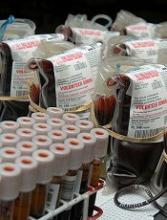A new type of hemoglobin-based oxygen carrier has shown early promise as a potential blood substitute, according to researchers.
The team created nanoparticles consisting of bovine hemoglobin coated with the polymer polydopamine (PDA).
Lab tests showed that hemoglobin-PDA nanoparticles effectively carried oxygen, caused minimal cell damage, and acted as antioxidants, scavenging for potentially damaging free radicals and reactive oxygen species (ROS).
Hong Zhou, PhD, of the Beijing Institute of Transfusion Medicine in China, and colleagues reported these results in Biomacromolecules.
Past attempts to develop chemically modified hemoglobin as a blood substitute have been hindered by the formation of methemoglobin.
Methemoglobin doesn’t bind oxygen and therefore decreases the amount of oxygen blood delivers in the body. In addition, the generation of methemoglobin produces hydrogen peroxide, which leads to cell damage.
Dr Zhou and colleagues wanted to see if packaging hemoglobin in a benign envelope could prevent these problems. So the team developed a one-step method for wrapping hemoglobin—extracted from bovine red cells—in PDA.
The researchers said their simple preparation method meant the nanoparticles maintained the integrity of hemoglobin’s chemical structure without introducing any toxic reagent.
In addition, the PDA coating allowed hemoglobin to maintain its oxygen-carrying ability by preventing the formation of methemoglobin.
The researchers found the hemoglobin-PDA nanoparticles to have “excellent antioxidant capacity,” as they scavenged free radicals. The team said the ABTS+ radical scavenging rate reached 89%, and the DPPH radical scavenging rate reached 49%.
The hemoglobin-PDA nanoparticles also demonstrated antioxidant capacity by suppressing ROS generation. They reduced hydrogen peroxide-induced ROS generation in H9c2 cells.
Furthermore, the hemoglobin-PDA nanoparticles had little effect on blood constituents and cell viability.
The researchers found the nanoparticles had minimal effects on platelet aggregation, hemolysis in red blood cells, and coagulation processes.
And the nanoparticles had no significant cytotoxic effects on human umbilical vein endothelial cells.
The researchers therefore concluded that their hemoglobin-PDA nanoparticles represent “promising progress” for hemoglobin-based oxygen carriers.


